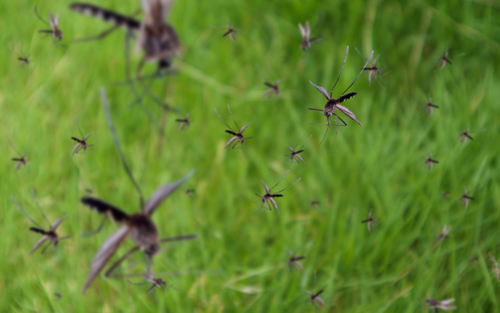Safely and Effectively Using Insect Repellents at Work
Insect bites can be more than an itchy nuisance for workers in bug-prone environments. Insects can transmit disease, cause allergic reactions, and significantly impact employee comfort and productivity. According to the World Mosquito Program, roughly 390 million people globally are infected yearly with dengue, with hundreds of thousands more affected by Zika, chikungunya, and yellow fever (World Mosquito Program, n.d.).
Fortunately, there are different types of insect repellents to protect your team from these threats. Below, we provide essential guidelines for choosing the appropriate insect protection and using them safely and effectively.
What types of insect repellents are safe for workplace use?
The Centers for Disease Control and Prevention (CDC) recommends using EPA-registered insect repellents with one of the following active ingredients:
- DEET (N, N-diethyl-meta-toluamide): DEET is a common active ingredient in many insect-repellent products. It is widely recognized for its ability to repel mosquitoes, ticks, and other biting insects. You can find DEET in insect sprays, lotions, and wipes. For general use, including workplace environments, we recommend repellents with 20% to 30% DEET concentrations to balance effectiveness and safety, likeCoretex BugX30.
- Picaridin: This synthetic compound is effective against insects, including mosquitoes, ticks, flies, and fleas. According to a study, picaridin is slightly more effective than DEET in repelling mosquitoes and equally effective against ticks (AMC, n.d.). Some users prefer it over DEET for its less greasy feel and lower odor.
- Oil of lemon eucalyptus (OLE): OLE is a natural insect repellent derived from the leaves of the lemon eucalyptus tree. It is popular with those seeking a natural alternative to synthetic repellents. While its insect protection may be comparable to DEET, it is often considered gentler on the skin.
- IR3535 (Ethyl butylacetylaminopropionate): A synthetic insect repellent developed by Merck KGaA, IR3535 is comparable to DEET in repelling various mosquitoes and ticks.
You can find the different insect repellent options offered by PK Safety here.
In addition to topical repellents, there are also insect-repellent-treatedsafety workwear, such as shirts, coveralls, and hats. These products feature textile treatments that target the sensory mechanisms of insects, discouraging them from landing on treated surfaces. They’re available in various forms, including:
- Pre-treated Fabrics
- Spray-on Repellents
- Wash-in Formulations
Each type offers distinct benefits depending on the user's needs, such as duration of protection and intensity of exposure to mosquito-prone areas.
How often should insect repellent be applied during work?
The frequency of applying insect repellent depends on several factors, including the type of repellent used, the level of insect activity, and the specific work conditions. We always recommend following the instructions on the product label, as different formulations have varying durations of effectiveness.
Here are other essential guidelines:
- DEET: Products with higher concentrations of DEET provide longer-lasting protection. For instance, a 30% DEET repellent can typically protect for up to six hours, while products with lower concentrations may require reapplication every two to four hours. According to the Occupational Safety and Health Administration (OSHA), products with more than 50% DEET may not significantly increase protection.
- Picaridin: Typically, picaridin-based repellents provide up to eight hours of protection. According to OSHA, “Research suggests that repellents containing DEET or picaridin typically provide longer-lasting protection than other products (OSHA, n.d.). Meanwhile, OLE provides longer-lasting protection than other plant-based repellents.
For outdoor workers, factors like sweating, heavy rain, and physical activity can reduce the effectiveness of repellents, necessitating more frequent applications. As such, we always recommend complementing topical solutions with bug-repellent gear, such as PIP long-sleeve shirts and coveralls.
What are the legal considerations for using insect repellents in the workplace?
While there are no specific federal regulations governing insect repellent use in the workplace, employers have a responsibility to provide safe working environments. This responsibility includes protection from insect-borne illnesses. Here are a few essential guidelines:
- EPA-registered Products: Use insect repellents with EPA-registered active ingredients. Using registered active ingredients guarantees that the products have been evaluated for safety and effectiveness.
- OSHA Guidelines: FollowOSHA worker rights and protections and other relevant disease or industry-specific regulations. For example, OSHA has specific guidelines for workers potentially exposed to the Zika virus. These include informing workers about the risks and training them to protect themselves.
- Training and Education: Employers should provide training on the safe use of insect repellents. For instance, while permethrin is a long-lasting repellent, it is intended for application to clothing and gear and not directly applied to the skin. Meanwhile, spraying DEET on clothing and gear made of synthetic fabrics may damage or dissolve the garments.
Finally, we recommend providing safety data sheets for all insect repellents used in the workplace. These documents provide information on the safe handling, use, and storage of insect-repellent products. Contact us today for more information on enhancing insect protection and othersafety supply needs for your workplace.
References:
- World Mosquito Program (n.d.). Mosquito-borne diseases. Retrieved from https://www.worldmosquitoprogram.org/en/learn/mosquito-borne-diseases
- Appalachian Mountain Club (n.d.). Picaridin vs DEET: Which Is the Best Insect Repellent? Retrieved from Picaridin vs DEET: Which Is the Best Insect Repellent? | Appalachian Mountain Club (AMC) (outdoors.org)
- Occupational Safety and Health Administration (n.d.) Interim Guidance for Protecting Workers
from Occupational Exposure to Zika Virus. Retrieved from OSHA3855.pdf
Recent Posts
-
Safely and Effectively Using Insect Repellents at Work
Insect bites can be more than an itchy nuisance for workers in bug-prone environments. Insects can t …Aug 16th 2024 -
RKI Instruments Single Gas Monitor: Best Carbon Monoxide Protection for Aircraft and Vehicles
Carbon monoxide (CO) has been known to be “the silent killer” because it’s a colorless, odorless, …Aug 16th 2024 -
August 12-18 is OSHA’s Safe + Sound Week 2024
Every August, the Occupational Safety and Health Administration (OSHA) spearheads Safe + Sound We …Aug 16th 2024





